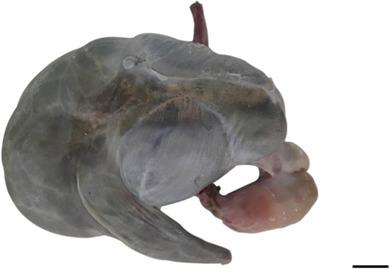当前位置:
X-MOL 学术
›
Microsc. Res. Tech.
›
论文详情
Our official English website, www.x-mol.net, welcomes your
feedback! (Note: you will need to create a separate account there.)
Sloths (Bradypus variegatus) as a polygastric mammal.
Microscopy Research and Technique ( IF 2.0 ) Pub Date : 2020-09-11 , DOI: 10.1002/jemt.23568 Ellen Y E Mesquita 1, 2 , Paola C Soares 1 , Luise R Mello 1 , Elisa C B Freire 1 , Ana R Lima 1 , Elane G Giese 1, 3 , Érika Branco 1
Microscopy Research and Technique ( IF 2.0 ) Pub Date : 2020-09-11 , DOI: 10.1002/jemt.23568 Ellen Y E Mesquita 1, 2 , Paola C Soares 1 , Luise R Mello 1 , Elisa C B Freire 1 , Ana R Lima 1 , Elane G Giese 1, 3 , Érika Branco 1
Affiliation

|
Fermentative herbivorous animals have peculiar conformations of the digestive system. It is known that B. variegatus obtained the capacity for evolutionary adaptation, due to their ecology and eating habits. However, despite the literature on feeding management for this species, there is a lack of published information regarding its gastric morphology, and such information would support a better understanding on the diet and digestion of these individuals. We found seven gastric compartments, which histologically revealed three distinct patterns: an aglandular keratinized fraction (mechanical stomach) and two glandular fractions, one a mucus secretor and the other one composed of acid secreting cells (chemical stomach). With these evidences we understand that these individuals have gastric resemblance to ruminants, with some inherent peculiarities of this species, including the transit of the bolus.
中文翻译:

树懒 (Bradypus variegatus) 作为一种多胃哺乳动物。
发酵食草动物具有特殊的消化系统构造。众所周知,B. variegatus由于它们的生态和饮食习惯,获得了进化适应的能力。然而,尽管有关于该物种饲养管理的文献,但缺乏关于其胃形态的公开信息,这些信息将有助于更好地了解这些个体的饮食和消化。我们发现了七个胃室,在组织学上揭示了三种不同的模式:一个腺体角化部分(机械胃)和两个腺体部分,一个是粘液分泌物,另一个由酸分泌细胞组成(化学胃)。有了这些证据,我们了解到这些个体与反刍动物的胃部相似,具有该物种的一些固有特性,包括食团的运输。
更新日期:2020-09-11
中文翻译:

树懒 (Bradypus variegatus) 作为一种多胃哺乳动物。
发酵食草动物具有特殊的消化系统构造。众所周知,B. variegatus由于它们的生态和饮食习惯,获得了进化适应的能力。然而,尽管有关于该物种饲养管理的文献,但缺乏关于其胃形态的公开信息,这些信息将有助于更好地了解这些个体的饮食和消化。我们发现了七个胃室,在组织学上揭示了三种不同的模式:一个腺体角化部分(机械胃)和两个腺体部分,一个是粘液分泌物,另一个由酸分泌细胞组成(化学胃)。有了这些证据,我们了解到这些个体与反刍动物的胃部相似,具有该物种的一些固有特性,包括食团的运输。









































 京公网安备 11010802027423号
京公网安备 11010802027423号